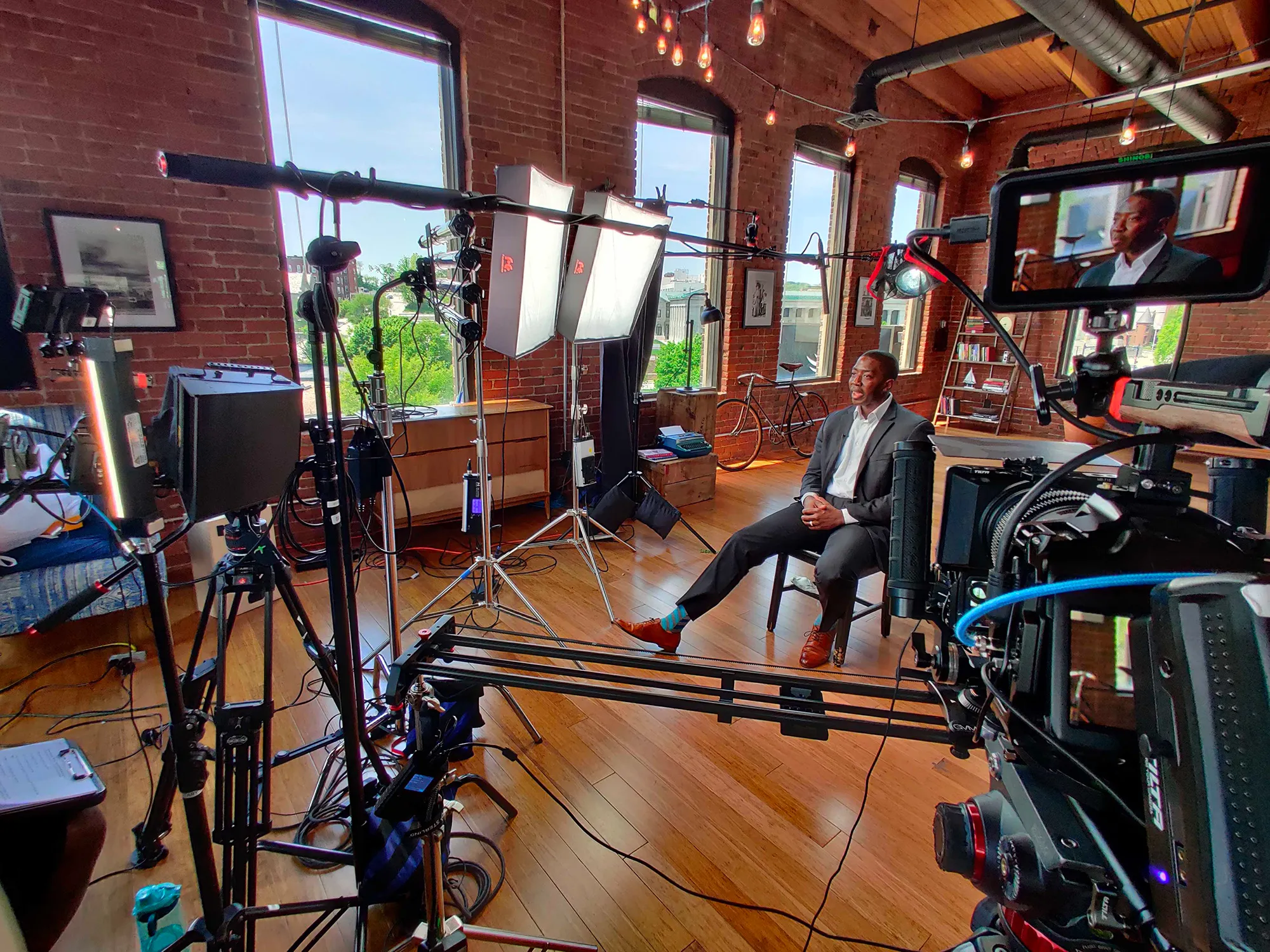
10 Mar How do Non-Profits tell the right stories through video?
Last year was tough. Whether it was the economy, marketing budget cuts, organizational dysfunction, lack of planning, or all of the above, we had a rough six months or so. A lot became clear in that time.
We’ve been fortunate in the past. We haven’t operated like a standard business operates. We’re a team of creatives, and sometimes we attract more like-minded people who are more creative first, process and systemized KPIs last. We all see the value in hiring people who don’t think the same way; people who help grow the business and are data-oriented. It’s necessary to have both, especially for creative businesses.
Another thing that became clear is defining our target partner. It’s always been an area that is difficult to clearly define, because almost every business out there can use video for their marketing. Almost every organization will benefit from video communications. So we should work with everyone, right? Well, we basically have worked with everyone… up until the last few years. We’ve become more clear on our ideal partner lately; those who get the most value out of working with us.
Who do we find ourselves working the best with? Organizations that have meaningful stories to tell, who see the importance of shining a light on those stories, who care about marketing that is evergreen over trendy, who care about telling the truth and highlighting values tend to love working with us, and vice versa.
These organizations keep coming back. They align with our mission to tell meaningful stories about truth, freedom, and human flourishing. They scratch the creative itch and it’s fulfilling on a personal note for us as storytellers, artists, filmmakers, and on a human-to-human level.
Many of these partners of ours are non-profits. We’re not exclusively partnered with non-profits. It’s not baked into our mission, but it’s something I’m noticing arise more and more. I personally have a lot of non-profit clients and they’ve become friends of mine over the years. Working with The New England Center for Children, or ATASK, WCAC, or Boys and Girls Club is really fulfilling.
What are the challenges of marketing a non-profit organization? What stories do you tell for your events or for your marketing campaigns?
In some ways, non-profit organizations have it easier than for-profit brands because chances are there are concrete examples of your efforts, your mission, and your values through real-life stories. But how do you tell those stories while remaining sensitive to the subject matter and the interviewees? Naturally having people on board for being on camera can be its own challenge, and then making sure their privacy is respected, sometimes even making sure their identity / name is changed in the videos is necessary as well.
How do you know what stories to tell? A temptation I see much of the time is wanting to cover too much ground with one video. There are too many characters. There’s too much ground being covered in the narrative. This is why we have our Development Process. It helps any organization align on the goals of a particular video and story in order to pair it down to the essentials, focus on key characters that can be the hero of the story, and keep the ideal result the target goal of the video throughout the process. This ensures throughout the production process that we’re allowing spontaneity, creativity, but not to the detriment of the final product. It has to hit the right goal, and that goal has to be clear from the beginning.
We recommend having no more than 3 main takeaways in every film. A video trying to do too much all at once can very easily fall on deaf ears because it becomes convoluted in its messaging. Sometimes having multiple characters all at once ends up feeling more like a general overview of a company, rather than a story that you can get lost in and inspired by. It’s like arriving at a party and being introduced to over 25 people in a few minutes. You don’t necessarily feel like you got to know any of them. I tend to be that person at a party that says hi to everyone and then next thing I know I’ve spent 2 hours talking to one person while the rest of the party has the volume turned down in the background. I guess I’d rather get to know one person on a deeper level than have a bunch of quick surface interactions depending on my mood.
I treat the projects I direct and produce in a similar fashion. I encourage clients to really ask themselves, “Is each character vital to the overall story? Does each person we’re interviewing have a totally unique experience that is exclusive to him/her but also ties in with the message as a whole?” It’s a tricky thing because the temptation is not wanting to leave anyone out. Naturally everyone will have a different voice, but you want the least amount of overlap in departments, experiences, etc.
This is part of why we’re all about crafting documentary series as well. A series of stories is great because it’s on-going residual marketing for you.
It’s also an opportunity to get to know a character or a few characters more intimately in a single video at a time, rather than creating just one video that is supposed to be the magic bullet for the whole brand.
“But what about our Gala at the end of the year? How do we fundraise properly through a story in a video that inspires action and helps us grow?” The same principles often apply here. We want to highlight a story that really aligns with the overall message you’re looking to convey. We want to help you find the right story that has a compelling hero to focus on. We want to craft the story with you in a way that moves people emotionally but also encourages action once it’s over. Creating something memorable is difficult. Creating something memorable that also highlights the right values, strengthens partnerships, and grows an organization monetarily is even harder.
This is what we’re good at. We know how to help you find a story, get to know the main characters, craft and plan out the story structure and key moments, list out b-roll visual opportunities that coincide with the messaging, and edit together a beautiful video that can reach an audience on a human-to-human level. Our goal is to make something not just watchable for your Gala event or website visitors, but for the rest of the world as well. We get a lot of inspiration from Netflix documentaries, short films we discover on Youtube, cinema as a whole, and our favorite scripted series. We don’t tend to be inspired by other commercials or corporate content. Most of it is boring, contrived, or the audience is so targeted that it’s not meant to be appreciated by the average viewer. However, there are some brands that understand this, and are way ahead of the rest.
Finding stories is possible no matter what kind of organization you are.
The strength many non-profit organizations have is that they are often missional. They are meeting a need in society, being a helping hand, shining a light on underserved populations, and thus have a wellspring of stories they can tell. This means they have a plethora of meaningful content to pull from and that often lends itself well to partnership with Votary.
But this isn’t exclusive to non-profits — it’s just an area that has naturally aligned with our mission, values, storytelling expertise, and proclivity towards crafting videos that make a positive impact on people’s lives. We’re a for-profit company, so we’re not shining a light on non-profits in a way that’s excluding partnership to anyone else. I don’t necessarily think non-profits are better than other companies. Life’s not that simple. I do think that nonprofits have unique opportunities for documentary storytelling. Some take advantage of this, and some need a lot of help.
What about budgets? “We’re a non-profit, so how are we supposed to pay top dollar for meaningful, well crafted, high production value video content?”
Naturally we know that “non-profit” does not mean “no money”. If that were the case, you’d just go under and wouldn’t be able to hire anyone or even be an organization. It’s a matter of allocating investment into the areas of the company that get a high return. Maybe your leaders aren’t really aware of the benefit of storytelling for the organization’s growth. Maybe your marketing heads are stuck in the dark ages of tiny marketing budgets and where that money goes. It’s not really up to me or my place to say where you should spend your money. This isn’t about the benefits of storytelling or marketing videos for your company. I will say that if you’re considering investing in marketing content at all and telling a real story that is unique to your business is not on the agenda, you’re most likely missing out. You’re missing out on marketing video content that will never go out of style, that pulls people in emotionally no matter their background or job, and highlights your key messages without being a salesperson or being heavy-handed. It’s content that will continually provide value, or should if done right, for as long as you’re in business, and potentially even longer than that.
Okay, so I gave the hard sell at the end there, but I’m really not trying to. I do this because I like crafting stories and directing videos, but it’s also about knowing it’s actually valuable for the people I partner with. Votary doesn’t want to just create videos here and there for people who are just “looking for an ad” or “need social content”. We want to make relationships with people who we care about, have meaningful stories to tell, and help them grow and reach people through utilizing our skills in storytelling and filmmaking.
What do you think? Start a Conversation.
